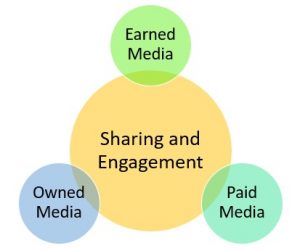4.2 Owned, Paid and Earned Marketing

Planning for success
Everyone plans to succeed in online marketing: create a few good blogs, a website, social media accounts and then sit back and relax, right? Well, no. It is not enough to have the owned media (the website, accounts, SM, landing pages, etc.). You also need a clear plan for paid marketing and an idea of how to harness earned media.
A comprehensive marketing plan acts as the sieve through which all content, social media platform choices, and key stories run. With prior planning of messaging and story, content creates cohesion and clarity for a customer. But before we get to creating a social plan, let’s take a look at two campaign routes that both need to be taken into consideration in every successful marking plan.
Paid marketing campaigns
Most social media platforms are set up to allow businesses to purchase advertisements. The campaign typically works by utilizing a pay-per-click (PPC) model: Choose the demographic, interests, and likes of target customers and pay each time your add is clicked/tapped-on. A brand should target within 2-4% of the broader market to get the most return on their advertising efforts. Paid advertising can drive traffic to your channels or website (i.e., through Google Ad words) and this can create measurable conversions (getting visitors to buy/connect). This method typically gives immediate results, and by setting the maximum amount you are willing to spend for each click, you can get a realistic bid and budget that is right for your organization.
For example, if you bid $1.50 maximum on the keyword ‘widgets’, and that’s the highest bid, you’ll probably show up first in line. If 100 people click on your PPC listing, then the search engine or PPC service will charge you a maximum of $150.
Depending on the platform, set-up and cost can vary significantly when it comes to PPC or any paid advertising.
The most important thing to remember when considering paid advertising on social media is to invest in advertising and marketing where your audience will actually find it! For example, if a business’ target audience is 50-65 years old then it doesn’t make sense to promote your brand on SnapChat because that is not where this demographic typically interacts. Furthermore, it is important to assess the return on investment (ROI), carefully: Is the result worth the cost, particularly with regard to conversions (i.e. calls or leads to actions). If the ROI is not adequate, then the campaign will need to be modified for future use. This kind of tweaking will result in the optimize your marketing budget.
Of course, other forms of paid advertising also fall into the overall marketing budget such as TV, billboard, radio ads, etc.
Earned or Organic marketing Campaigns
Earned marketing happens when content, a video or a photo that has been created and shared is seen as valuable to others. Often sharing and giving value through information and product tips for free, will get a business’ attention.
Social media marketers often hear their bosses telling them to make a post, blog article or video “go viral”. Brands often have a very hard time of this because the modern consumer is very wary of any content that is sale-sy or overly humanistic. Emotion is a powerful motivator. Apple Inc. has done an amazing job, year after year of making us believe their products will make a happier, merrier Christmas for everyone with their video advertisements. Businesses need to be very careful and wary of this technique to ensure an attempt at pulling heartstrings doesn’t backfire and result in negative reactions. (Remember the Kendall Jenner Pepsi Ad?)
People and companies want to see the personality and authenticity behind a brand. Personal messages and carefully curated content can be a magic combination.
What Is Paid Media?
Paid media is when a business pays to show its message to more people. This includes:
- Social media ads (like on Instagram or TikTok)
- Google search ads
- Sponsored posts
Paid media helps businesses reach new audiences quickly. Most platforms use a pay-per-click (PPC) system, which means the business pays only when someone clicks on the ad.
Example:
If a company bids $1.50 for the keyword “eco water bottle,” and 100 people click the ad, the company pays $150 total.
Tip:
Businesses should advertise where their audience spends time. For example, if the target audience is older adults, TikTok might not be the best place to advertise.
What Is Earned Media?
Earned media is when people share or talk about a business without being paid. This includes:
- Shares and likes on social media
- Customer reviews
- Mentions in blogs or news articles
Earned media is powerful because it shows that people trust and value the business. It’s like free advertising from happy customers.
Why Use All Three?
Using Owned, Paid, and Earned media together creates a strong marketing plan. Each type supports the others:
- Owned media gives a place to share content.
- Paid media brings in new visitors.
- Earned media builds trust and spreads the word.
EXERCISE 4.1 Reflect on a social ad you saw recently
Think of a time when you saw a social media advertisement – a reel, story, clip, photo, etc. Briefly reflect on how relevant the post was to you by considering the following questions:
- What was the post’s goal?
- What was your alignment with the business?
- Was the outcome successful, did you click through the ad?
- If you clicked-through did you find what you expected at the end of the link?
- What do you think the business could have done better to capture your attention?
Media Attributions
- Digital_marketing-trifecta

